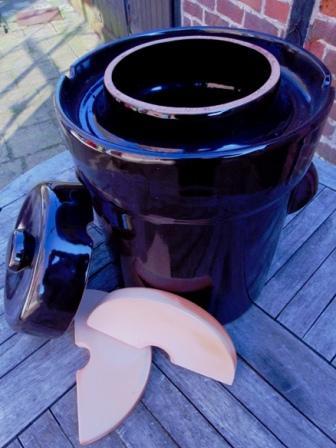Sauerkraut is sliced cabbage that has been preserved by the action of various lactic acid bacteria. It contains vitamin B and iron, and a lot of vitamin C. This could prevent earlier scurvy during long boat trips.
 Cut the cabbage (without heart or stump) fine, press it very firmly in a bowl and lightly salt (about 1.5% salt) it. By pressing and crushing the strips they must be under wet. Repeat until the pot is about full. Cover with cabbage leafs and weigh with stones, so that no air can enter and a brine seal is created. He yeast in 3 to 8 weeks to sauerkraut. This can smell.
Cut the cabbage (without heart or stump) fine, press it very firmly in a bowl and lightly salt (about 1.5% salt) it. By pressing and crushing the strips they must be under wet. Repeat until the pot is about full. Cover with cabbage leafs and weigh with stones, so that no air can enter and a brine seal is created. He yeast in 3 to 8 weeks to sauerkraut. This can smell.
There may come a white yeast film “scum” (not slime) on the moisture. You can just skim it.
As long as the sauerkrautis under brine (sealed from air) he remains good. You can save it so easy for six months or even a year. A handy sauerkraut pot has a water groove for the lid, that seals like an air lock (double border with water, and fitting lid in it.).
You can expand the recipe with juniper and various herbs.
Also possible are beans, peppers, celery, some apple slices, green tomato, pickle, peppers in different proportions.
In France they have like sauerkraut grated turnips with salt and juniper: choucroute de navets. The Romans also added honey and vinegar or mustard.
Acidification is a healthy storage technology. This changed cabbage and milk into sauerkraut and yogurt, unattractive to rotting bacteria by the unsuitable, too acidic environment. In fermentation lactic acid bacteria convert the sugars naturally present in milk to acids. Or yeasts convert sugars into carbon dioxide, or as in beer and wine, even in alcohol. Sauerkraut is between pH 2.8 and 3.6. Lower = more acidic.
I also use my sauerkraut pot to make sangria in the summer and keep it perfectly cool.
Fermentation is a kind of cold preparation. Micro-organisms (bacteria, fungi and yeasts) thrive in heat and moisture, and produce enzymes that change the acidity, taste, smell, appearance, digestibility and shelf life of the product. Sugars are converted into alcohols and acids. This makes the end product rich in probiotics (which support beneficial bacteria in your intestines) and is better to digest. Often it can also be stored longer. Fermentation can take place with or without oxygen.
Fermentation vessels have been found in China (7,000 BC) and Georgia (6,000 BC), Egypt and Babylon.
Examples are sauerkraut and yogurt, sourdough, beer of fermented barley, cider, cheese, tempé, wine, kimchi, soy sauce, dry sausage and vinegar, kimchi, natto, tape, tempeh, kombucha, fish sauce and sake, miso, gari and fermented millet porridge, tabasco, sour cream, cottage cheese, prosciutto, buds (herring) and meat fermenting produces salami.
1. Protect your product from spoilage, prevent bad micro-organisms by creating a good environment with eg. saline, a culture, extract oxygen or increase acidity by adding vinegar or whey, or juice from a previous fermentation.
2. Ensure the correct environment, usually room temperature. Store it later cool in a cellar or fridge.
3. Provide sugars and fungi. Fruit, vegetables, dairy and grains already contain all of them.
Fermentation also requires time: days, weeks, sometimes even months.
